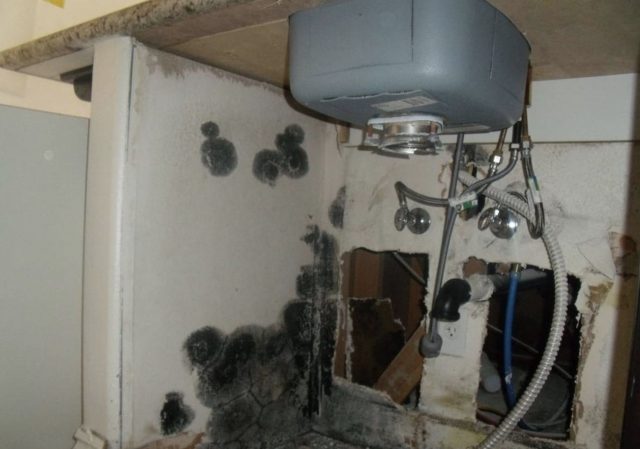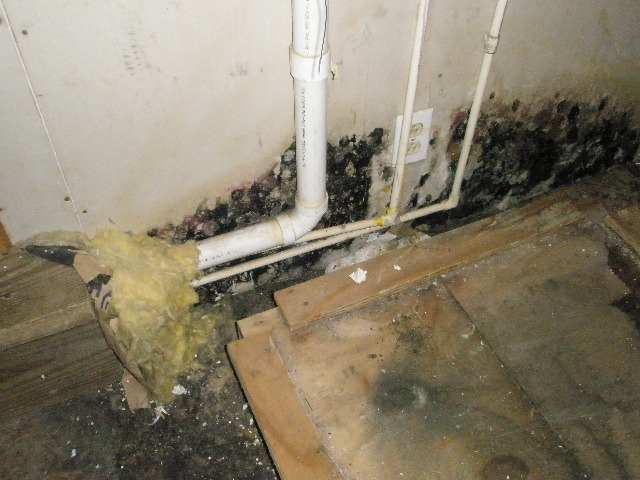Mold is a common problem in many homes, and one of the most common places for it to grow is under the kitchen sink. This can be a health hazard for you and your family, as well as causing damage to your cabinets and pipes. In this section, we will discuss the steps you can take to effectively remove mold from under your kitchen sink.How to Remove Mold Under Kitchen Sink
The best way to deal with mold is to prevent it from growing in the first place. This is especially important when it comes to areas like under the kitchen sink, which are prone to moisture and darkness. To prevent mold growth, make sure to regularly check for leaks and fix them immediately. Keep the area under your sink dry by wiping up any spills or leaks right away. You can also use a dehumidifier or a fan to reduce moisture in the air.Preventing Mold Growth Under Kitchen Sink
If you do find mold under your kitchen sink, there are a few DIY methods you can try to remove it. First, you will need to put on protective gear, such as gloves and a mask, to avoid breathing in mold spores. Then, mix a solution of one part water and one part white vinegar in a spray bottle. Spray the affected area and let it sit for 15 minutes before wiping it clean with a cloth. You can also use a mixture of baking soda and water to scrub away mold. If the mold is stubborn, you may need to use a commercial mold cleaner.DIY Mold Removal for Kitchen Sink
If DIY methods are not effective, you can also purchase mold removal products specifically designed for kitchen sinks. Look for products that contain chlorine bleach, ammonia, or hydrogen peroxide, as these are powerful agents that can kill mold and prevent it from coming back. Be sure to follow the instructions on the product carefully and use protective gear as directed.Best Products for Removing Mold Under Kitchen Sink
Mold can be sneaky and may not always be visible. However, there are some signs that can indicate its presence under your kitchen sink. These include a musty or damp smell, discoloration or staining on your cabinets or walls, and the presence of small black or green spots. If you notice any of these signs, it is important to take action right away to prevent the mold from spreading.Signs of Mold Under Kitchen Sink
Mold under your kitchen sink can pose a threat to your health and the health of your family. Breathing in mold spores can cause allergic reactions, respiratory problems, and even infections. It can also aggravate existing health conditions such as asthma. If you or your family members are experiencing symptoms like coughing, sneezing, or wheezing, it may be a sign of mold under your sink and should be addressed immediately.Health Risks of Mold Under Kitchen Sink
If the mold is extensive or difficult to remove, it is best to seek professional help. Mold remediation experts have the knowledge, experience, and equipment to safely and effectively remove mold from your kitchen sink. They can also identify the underlying cause of the mold growth and provide solutions to prevent it from happening again in the future.Professional Mold Removal for Kitchen Sink
In order to prevent mold from growing under your kitchen sink, it is important to understand the common causes of its growth. Leaks or drips from pipes, poor ventilation, and high humidity levels are all factors that can contribute to mold growth. It is important to regularly check for any leaks and address them immediately to prevent mold from forming.Common Causes of Mold Under Kitchen Sink
In addition to fixing leaks and maintaining good ventilation, there are other steps you can take to keep your kitchen sink mold-free. Regularly cleaning and disinfecting the area under your sink can prevent mold from growing. You can also use mold-resistant materials for your cabinets and pipes. Additionally, make sure to regularly check and replace the seals on your sink to prevent water from seeping in and causing mold growth.Tips for Keeping Kitchen Sink Mold-Free
Once you have successfully removed the mold from under your kitchen sink, it is important to thoroughly clean and disinfect the area to prevent it from coming back. Use a mixture of water and bleach to clean the affected area and then a disinfectant to kill any remaining mold spores. Make sure to thoroughly dry the area afterwards to prevent moisture from lingering and promoting mold growth.How to Clean and Disinfect Mold Under Kitchen Sink
How to Get Rid of Mould Under Your Kitchen Sink

The Hidden Danger of Mould in Your Kitchen
 If you've ever noticed a musty smell coming from your kitchen, chances are you have a mould problem. While mould can grow in any damp and dark area of your home, the kitchen is a common breeding ground due to the presence of moisture and food particles. One area that is particularly prone to mould growth is under the kitchen sink. This is because it is often dark, humid, and can easily accumulate water from leaks or spills. Not only is mould unsightly, but it can also pose health risks to you and your family. Therefore, it is important to address and prevent mould growth in your kitchen, especially under the sink.
If you've ever noticed a musty smell coming from your kitchen, chances are you have a mould problem. While mould can grow in any damp and dark area of your home, the kitchen is a common breeding ground due to the presence of moisture and food particles. One area that is particularly prone to mould growth is under the kitchen sink. This is because it is often dark, humid, and can easily accumulate water from leaks or spills. Not only is mould unsightly, but it can also pose health risks to you and your family. Therefore, it is important to address and prevent mould growth in your kitchen, especially under the sink.
Causes of Mould Under Your Kitchen Sink
 Mould thrives in damp and dark environments, making the area under your kitchen sink the perfect breeding ground. The main cause of mould growth under the sink is moisture. Leaky pipes, dripping faucets, and spills that are not properly cleaned up can all contribute to excess moisture. Additionally, poor ventilation and lack of sunlight can also contribute to mould growth. The presence of food particles or organic matter can also provide a food source for mould to grow on.
Mould thrives in damp and dark environments, making the area under your kitchen sink the perfect breeding ground. The main cause of mould growth under the sink is moisture. Leaky pipes, dripping faucets, and spills that are not properly cleaned up can all contribute to excess moisture. Additionally, poor ventilation and lack of sunlight can also contribute to mould growth. The presence of food particles or organic matter can also provide a food source for mould to grow on.
Steps to Get Rid of Mould Under Your Kitchen Sink
 Getting rid of mould under your kitchen sink may seem like a daunting task, but it can be done with the right approach. Here are the steps you can take to get rid of mould and prevent it from coming back:
1. Identify and fix the source of moisture:
The first step is to identify and fix any leaks or sources of moisture under your sink. This may involve tightening pipe connections, fixing a leaky faucet, or drying up any spills.
2. Clean and disinfect:
Use a mixture of water and
bleach
or
vinegar
to clean the affected area. Scrub away any visible mould and wipe down all surfaces. This will not only remove the mould but also disinfect the area to prevent further growth.
3. Dry the area:
After cleaning, be sure to thoroughly dry the area under the sink. Use a fan or dehumidifier to speed up the process and ensure that there is no excess moisture left.
4. Use mould-resistant materials:
When replacing any materials under your sink, opt for
mould-resistant
options such as
PVC pipes
or
waterproof sealant
to prevent future mould growth.
5. Improve ventilation and sunlight:
To prevent mould from coming back, ensure that your kitchen has proper ventilation and gets enough sunlight. This will help to keep the area dry and discourage mould growth.
Getting rid of mould under your kitchen sink may seem like a daunting task, but it can be done with the right approach. Here are the steps you can take to get rid of mould and prevent it from coming back:
1. Identify and fix the source of moisture:
The first step is to identify and fix any leaks or sources of moisture under your sink. This may involve tightening pipe connections, fixing a leaky faucet, or drying up any spills.
2. Clean and disinfect:
Use a mixture of water and
bleach
or
vinegar
to clean the affected area. Scrub away any visible mould and wipe down all surfaces. This will not only remove the mould but also disinfect the area to prevent further growth.
3. Dry the area:
After cleaning, be sure to thoroughly dry the area under the sink. Use a fan or dehumidifier to speed up the process and ensure that there is no excess moisture left.
4. Use mould-resistant materials:
When replacing any materials under your sink, opt for
mould-resistant
options such as
PVC pipes
or
waterproof sealant
to prevent future mould growth.
5. Improve ventilation and sunlight:
To prevent mould from coming back, ensure that your kitchen has proper ventilation and gets enough sunlight. This will help to keep the area dry and discourage mould growth.
In Summary
 Mould under the kitchen sink is a common problem that can be easily addressed and prevented. By fixing any sources of moisture, thoroughly cleaning and disinfecting, and improving ventilation and sunlight, you can get rid of mould and keep your kitchen healthy and mould-free. Keep these tips in mind for a clean and well-maintained kitchen.
Mould under the kitchen sink is a common problem that can be easily addressed and prevented. By fixing any sources of moisture, thoroughly cleaning and disinfecting, and improving ventilation and sunlight, you can get rid of mould and keep your kitchen healthy and mould-free. Keep these tips in mind for a clean and well-maintained kitchen.












:max_bytes(150000):strip_icc()/water-pipe-under-kitchen-sink-980755976-c96f97e5339142c39e296fe03faba923.jpg)


























































